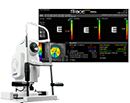Why Leading Surgeons like Dr. Woolfson Are Making iTrace Data a Standard Part of their Workup
Meet Jonathan Woolfson, MD
While advanced new vision correction methods are making excellent visual outcomes accessible for a larger patient population, they also make it imperative that decisions are made with confidence based on reliable, ultra-accurate measurements and data.
Woolfson Eye Institute employs over 20 surgeons across its locations, so before the group acquired its first iTrace, Dr. Woolfson and his team faced a challenge:
How could they make sure the entire staff — regardless of location — had standardized markers on which to base key clinical decisions?
Since purchasing the first iTrace more than a decade ago years ago, Dr. Woolfson has utilized its cutting-edge technology and advanced metrics to help his team make better decisions for the thousands of unique cases they see each year.
With objective data from the iTrace, Dr. Woolfson has found that his clinics are able to follow a very efficient, easy-to-learn set of decision points that allows them to confidently select the best course of vision correction.
That’s why now, Dr. Woolfson ensures that not only does he purchase an iTrace for every one of his locations, but also, that every surgeon at the Woolfson Eye Institute is trained to use it and employ it in their everyday workflow.
In his presentation at ASCRS 2024, Dr. Woolfson walked us through a few cases where the iTrace has made it much easier to get the best outcomes for his patients:
Case A: 60-year-old patient with history of prior LASIK surgery presenting with cataracts
Case A: 60-year-old patient with history of prior LASIK surgery presenting with cataracts

In the past, the surgeon would take measurements and manually analyze data points to determine the I-S point — a lengthy process that is far from guaranteed to produce the best results.
The iTrace automatically calculates and displays topography data on a user-friendly dashboard after a single scan. This streamlined information allows Dr. Woolfson to accurately determine the patient’s prescription, plan the surgery effectively, and achieve an optimal outcome on the first try.
Case B: 50-year-old patient with a complex eye health and vision history
When a patient comes in with a history of glaucoma, AMD, retinal tear, prior LASIK, a minimal prescription and only a minimal amount of cataract, but having trouble reading and driving at night, it can be difficult to truly know what is causing the symptoms.
With the iTrace’s Dysfunctional Lens Index (DLI), Dr. Woolfson was able to objectively rule out that the cataract was causing the problem — avoiding a potential bad recommendation. He used the iTrace to examine how the patient’s vision would be if the pupil size was manipulated, determined that eye drops would reduce the glare the patient was experiencing, all while easily educating the patient on why cataract surgeon wouldn’t get the outcomes they were looking for.
Click to schedule a demo or learn more about why the iTrace has become an indispensable tool for world-class clinics like the Woolfson Eye Institute.

